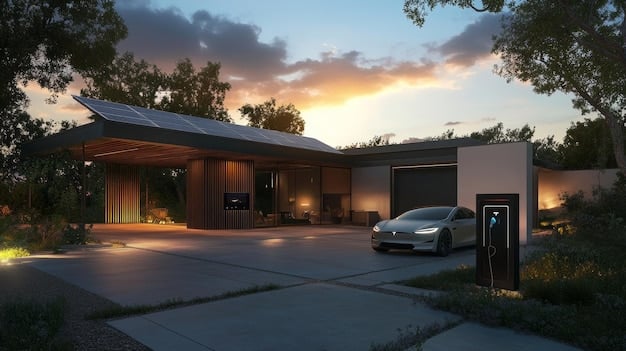Latest Renewable Energy Technology for US Homes & Businesses

Anúncios
The latest advancements in renewable energy technology for US homes and businesses include more efficient solar panels, advanced battery storage solutions, smart grid technologies, and innovative approaches to geothermal and wind energy, all aimed at making renewable energy more accessible and reliable.
The landscape of energy consumption is rapidly changing. Driven by environmental concerns and the pursuit of energy independence, the demand for renewable energy solutions is at an all-time high. Let’s explore what are the latest advancements in renewable energy technology for US homes and businesses, focusing on innovations that are reshaping how we power our lives and our economy.
Anúncios
Solar Power Innovations
Solar energy remains a cornerstone of the renewable energy transition. Ongoing innovations are drastically improving the efficiency and affordability of solar technology, making it an increasingly attractive option for both homeowners and businesses in the United States.
Next-Generation Solar Panels
Traditional silicon-based solar panels have been the industry standard for decades. However, newer technologies are emerging that promise higher efficiency and lower costs.
Anúncios
- Perovskite Solar Cells: Perovskites are materials with a crystal structure that allows them to absorb sunlight more efficiently than silicon. They are also cheaper to produce, potentially leading to significantly lower costs for solar panels.
- Bifacial Solar Panels: Unlike traditional panels that only capture sunlight from one side, bifacial panels can absorb sunlight from both the front and back. This can increase energy production by up to 30%, especially in environments with reflective surfaces.
- Thin-Film Solar Cells: These panels are made by depositing thin layers of photovoltaic material onto a substrate. They are lightweight, flexible, and can be manufactured at a lower cost than silicon panels.

These advancements are not just theoretical. Companies are already beginning to incorporate these technologies into their products, offering consumers more efficient and cost-effective solar solutions.
Advanced Battery Storage Solutions
One of the biggest challenges in renewable energy is intermittency. Solar and wind power are dependent on weather conditions, meaning they are not always available when needed. Advanced battery storage solutions are crucial for addressing this challenge, allowing excess energy to be stored and used when renewable sources are not generating power.
Lithium-Ion Batteries and Beyond
Lithium-ion batteries have become the dominant technology for energy storage due to their high energy density and relatively long lifespan. However, research is ongoing to develop even better battery technologies.
- Solid-State Batteries: These batteries use a solid electrolyte instead of a liquid one, making them safer, more energy-dense, and longer-lasting than traditional lithium-ion batteries.
- Flow Batteries: Flow batteries store energy in liquid electrolytes, offering greater scalability and longer lifespans than lithium-ion batteries. They are particularly well-suited for grid-scale energy storage.
- Sodium-Ion Batteries: Sodium-ion batteries use sodium instead of lithium, which is a more abundant and cheaper material. While they have a lower energy density than lithium-ion batteries, they are a promising alternative for certain applications.
These battery storage solutions are increasingly being integrated into homes and businesses, allowing them to store excess solar energy and use it during peak demand hours or during power outages. This not only reduces reliance on the grid but also enhances energy resilience.
Smart Grid Technologies
The integration of renewable energy sources requires a modernized grid capable of handling the variability and distributed nature of these sources. Smart grid technologies are essential for managing the flow of electricity and ensuring grid stability.
Enhancing Grid Efficiency and Reliability
Smart grids use advanced sensors, communication networks, and data analytics to optimize the operation of the electricity grid. This includes:
- Advanced Metering Infrastructure (AMI): Smart meters provide real-time data on energy consumption, allowing utilities to better manage demand and detect outages.
- Demand Response Programs: These programs incentivize consumers to reduce their energy consumption during peak demand periods, helping to prevent grid overloads.
- Energy Management Systems (EMS): EMS systems use sophisticated algorithms to optimize the operation of the grid, ensuring that renewable energy is integrated efficiently and reliably.

By implementing smart grid technologies, the US can create a more resilient and efficient energy system that is capable of supporting a high penetration of renewable energy sources.
Geothermal Energy Advancements
Geothermal energy, harnessing heat from the Earth, offers a consistent and reliable renewable energy source. Recent advancements are making geothermal more accessible and efficient for US homes and businesses.
Enhanced Geothermal Systems (EGS)
Traditional geothermal energy relies on underground reservoirs of hot water or steam. Enhanced Geothermal Systems (EGS) expand the potential of geothermal energy by creating artificial reservoirs in hot, dry rocks.
- Hydraulic Fracturing: EGS involves fracturing the rocks deep underground to create pathways for water to flow. The water is then heated by the hot rocks and brought to the surface to generate electricity.
- Closed-Loop Systems: These systems circulate a working fluid through a closed loop, eliminating the need for underground reservoirs. This reduces the risk of induced seismicity and allows geothermal energy to be harnessed in a wider range of locations.
EGS can significantly increase the availability of geothermal energy, making it a viable option for many regions that were previously unsuitable for traditional geothermal power.
Wind Energy Innovations
Wind energy has become a major source of renewable electricity in the US. Ongoing innovations are focused on increasing turbine efficiency, reducing costs, and expanding the geographic reach of wind power.
Larger and More Efficient Turbines
Modern wind turbines are significantly larger and more efficient than their predecessors. Key advancements include:
- Larger Rotor Diameters: Larger rotors capture more wind energy, increasing electricity production.
- Taller Towers: Taller towers allow turbines to access stronger and more consistent winds.
- Advanced Blade Designs: New blade designs improve aerodynamic efficiency, maximizing energy capture.
These advancements are driving down the cost of wind energy, making it increasingly competitive with fossil fuels. Offshore wind energy is also gaining momentum in the US, offering access to stronger and more consistent winds than onshore locations. These innovations are driving down the cost of wind energy and making it a more accessible and affordable option for businesses and homeowners.
Policy and Investment in Renewable Energy
Government policies and private investments play a crucial role in driving the adoption of renewable energy technologies. The US government has implemented a range of policies to support the development and deployment of renewable energy.
Incentives and Regulations
Key policies include:
- Tax Credits: Tax credits for renewable energy projects reduce the upfront costs of installing solar panels, wind turbines, and other renewable energy systems.
- Renewable Portfolio Standards (RPS): RPS mandates require utilities to generate a certain percentage of their electricity from renewable sources.
- Grants and Loans: Government grants and loans provide financial support for renewable energy projects, helping to overcome barriers to entry.
These policies are creating a favorable environment for renewable energy investment, driving innovation and accelerating the transition to a cleaner energy future. A combination of technological advancements, supportive policies, and increasing consumer demand is paving the way for a more sustainable energy future in the US.
| Key Point | Brief Description |
|---|---|
| ☀️ Next-Gen Solar | Perovskite & bifacial panels boost efficiency and cut costs. |
| 🔋 Battery Storage | Solid-state and flow batteries enhance energy storage reliability. |
| ⚡ Smart Grids | AMI and EMS optimize energy distribution and grid stability. |
| 🌍 Geothermal Advancements | EGS expands geothermal use via hydraulic fracturing and closed-loop systems. |
FAQ
▼
Perovskite solar cells use a crystal structure that absorbs sunlight more efficiently than traditional silicon, potentially reducing solar panel costs and increasing efficiency.
▼
Solid-state batteries use a solid electrolyte instead of a liquid, making them safer, more energy-dense, and longer-lasting than lithium-ion batteries.
▼
A smart grid uses advanced sensors, communication networks, and data analytics to optimize electricity grid operation, improving efficiency and reliability.
▼
EGS creates artificial reservoirs in hot, dry rocks by using hydraulic fracturing, expanding the potential of geothermal energy to more locations.
▼
US policies include tax credits, Renewable Portfolio Standards (RPS), and government grants and loans, which incentivize renewable energy development and adoption.
Conclusion
The latest advancements in renewable energy technology are transforming how the US powers its homes and businesses. From more efficient solar panels and advanced battery storage to smart grid innovations and enhanced geothermal systems, these technologies are making renewable energy more accessible, reliable, and cost-effective. Supported by government policies and private investments, the future of energy in the US is increasingly green and sustainable.





